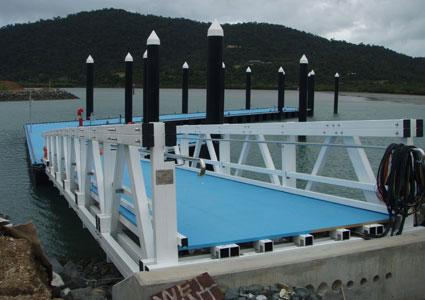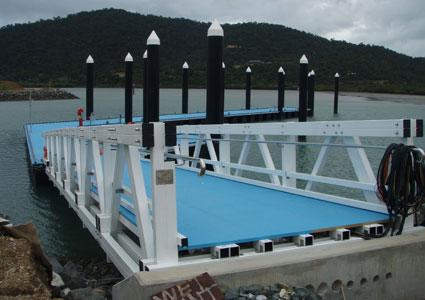Composite Ferry Pontoon Floats in Australia
July 2, 2012

Australian companies Wagners Composite Fibre Technologies (CFT) and Riverside Marine have joined forces to create a floating, all-composite ferry pontoon that they say will be the first of its kind.
The structure is 374 feet long and has a deck area totaling 6,168 square feet. It is designed to accommodate five high-speed catamaran ferries during cyclone conditions. The floating pontoon has been installed at Airlie Beach in Queensland, Australia.
Wagners CFT brings to the project a proprietary, pultruded engineering composite made of glass fiber and vinyl ester resins in the form of prefabricated structural sections. The geometry and shape of these sections are similar to the geometry and shape of traditional structural sections made of rolled hollow steel (RHS). Wagners' product is used in several structural applications, including mining structures, multi-span heavy load road bridges, electrical utility substation structures, boardwalks, and marine structures such as small boat pontoon floats and large jetties.

Because metallic structures in the harsh marine environment require ongoing maintenance due to corrosion and degradation, Riverside Marine's aim was to develop a solution using composite materials that would require zero maintenance, Gareth Williams, research and development engineer, has reportedly said. The company determined that using Wagners CFT's materials would both reduce maintenance and double the existing design life of a similar structure made of metallic or concrete-based materials.
To ballast the lightweight composite structure and improve its dynamic response characteristics, Wagners also used its premixed Earth-Friendly Concrete (EFC) product. This material is a traditional concrete that does not contain Portland cement, which reduces the carbon emissions associated with that material by 80 percent to 90 percent. Instead, EFC uses a geopolymer binder system. This system is made from the chemical activation of blast furnace slag, which is waste from iron production, and fly ash, which is waste from coal-fired power generation.
Wagners CFT says that the EFC concrete's performance is equal to or better than traditional concrete and has some advantages, including better durability, less shrinkage, faster strength gain, and higher flexural tensile strength.
Aside from carbon-fiber and glass-fiber composites in aerospace structures such as Virgin's SpaceShipTwo and the Juno spacecraft, other plastics used in structural applications include recycled plastic bottles turned into bridge pilings and I-beams and heavy truck parts.
Related posts:
About the Author(s)
You May Also Like


.jpg?width=300&auto=webp&quality=80&disable=upscale)
